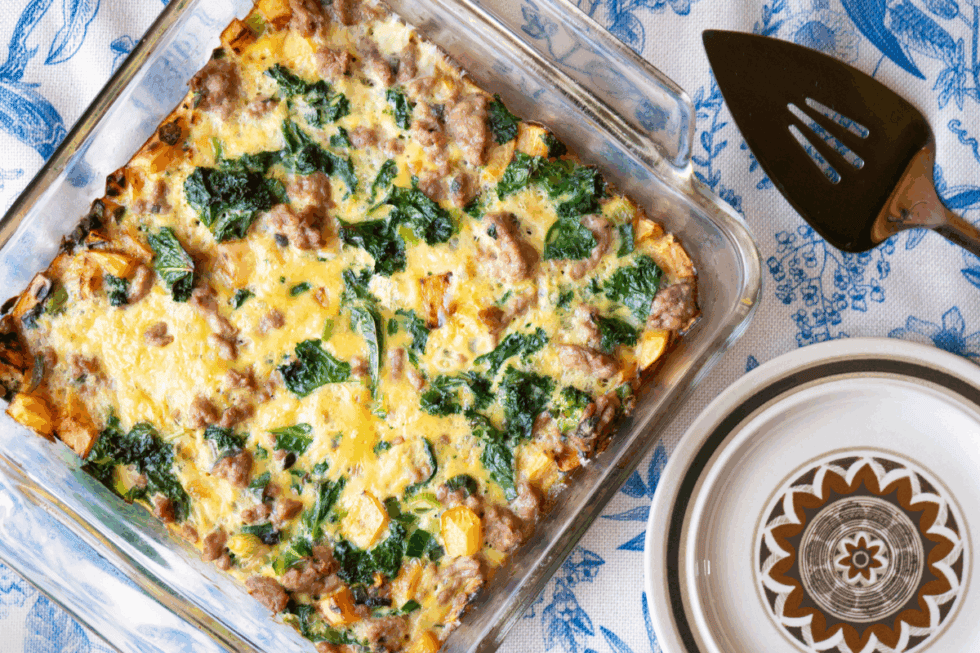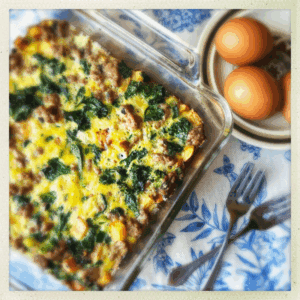
Low Histamine, Low FODMAP Breakfast Casserole (also Low Oxalate and Low Lectin)
Planning a brunch for friends and family and need a low FODMAP breakfast casserole?
We’ve got you covered with this low FODMAP recipe.
This recipe is:
- Low histamine
- Low oxalate
- Low lectin
- Low FODMAP
- Dairy free
- Gluten free
- Vegetarian option
This recipe is perfect for serving crowds.
Egg preparations like omelets require a lot of time in front of the stove when you’re cooking for a crowd. And by the time the last omelet is done, the first one has gone cold.
This breakfast casserole gets you out of the kitchen and back to enjoying your friends and family.
Don’t need to feed a lot of people? This recipe also freezes and reheats well for “cook once, eat often” meal prep.
Be sure to read our tips on reheating in the microwave, stovetop, or air fryer.
Keep reading for:
- More on how Mast Cell Activation Syndrome (MCAS) and FODMAP Intolerance may relate
- What to know about eggs and the low histamine diet
- Our low FODMAP, low histamine food swaps
- Tips for making the recipe (Including changes to make for muffin pan vs baking dish!)
First up, here’s the quick version of how FODMAPs and MCAS can relate. In this upcoming section, you’ll also get a resource to learn more.
Low FODMAP Breakfast Casserole: What to Know About FODMAPS and Mast Cell Activation Syndrome (MCAS)
Before you change your diet on your own, please make sure you’re working with a healthcare practitioner who can help you with this. Never limit foods unnecessarily, and always have a licensed medical provider who is supervising your case.
FODMAPS are a type of carbohydrate found in some foods.
People with FODMAP Intolerance have trouble digesting these particular types of carbs.
FODMAP Intolerance symptoms can be similar to IBS (irritable bowel syndrome) symptoms.
But how do FODMAP Intolerance and Mast Cell Activation Syndrome (MCAS) relate?
For some people, Mast Cell Activation Syndrome can lead to food intolerances like FODMAP Intolerance.
And for some people, existing food intolerances can be mast cell triggers that add to your symptoms.
Learn more: FODMAP Intolerance: What to Know if You Have Mast Cell Activation Syndrome or Histamine Intolerance
In either case, elimination diets may be helpful for getting symptoms and mast cells under control.
Not everyone with MCAS has FODMAP Intolerance. Always talk with your provider before starting elimination diets like the low FODMAP diet.
For most people, food intolerances like FODMAP Intolerance can be managed with the right guidance.
In fact, we strive to add all types of foods back into meal plans in moderation.
If you love eggs for breakfast, you’ll be glad to know that eggs are low FODMAP.
But here’s what to consider about eggs if you’re following the low histamine diet, too.
Eggs and the Low Histamine Diet
Food intolerances happen when the body can’t digest certain components of food.
With FODMAP Intolerance, it’s the short chain carbs:
- Fermentable
- Oligosaccharides
- Disaccharides
- Monosaccharides
- Polyols
Similarly, if your body has trouble processing histamine, that’s Histamine Intolerance.
What is histamine?
Histamine is a chemical your body naturally produces. It plays many important roles.
Histamine is also a natural compound found in some foods.
In food, histamine is often a result of bacteria or other microorganisms.
That’s why fermented foods, cheeses, and aged meats tend to be higher histamine.
Other foods listed as high histamine may actually be histamine liberators.This means they may not be high histamine, but they trigger your body to release histamine.
So, you’ll sometimes see these histamine liberators as things to avoid with Histamine Intolerance.
Eggs are low FODMAP.
And the SIGHI list says that eggs are typically well-tolerated for those with Histamine Intolerance.
The Swiss Interest Group Histamine Intolerance (SIGHI) is a respected organization that provides information about histamine-related disorders.
So, if eggs are considered well-tolerated, why do we recommend eliminating eggs in phase 1 of the low histamine diet for MCAS?
More About Egg Intolerance
Intolerance and allergy are 2 different things. But both could contribute to histamine levels in your body.
An allergy is an immune response.
If you are truly allergic to eggs, eating them can cause histamine release. This is a normal immune response. But it adds to your histamine load.
Most people with allergies tend to know it because reactions typically happen quickly and can be severe.
Avoid eggs if you have a true egg allergy.
Egg intolerance is a digestive response.
People with egg intolerance often have trouble digesting the proteins found in eggs.
Remember you read earlier that food intolerance of any kind can lead to mast cell activation.
And triggered mast cells can release histamine, thus adding to your histamine load.
Many people who have egg intolerance don’t even know it!
You may not realize you have egg intolerance because of delayed responses.
Intolerance reactions can take multiple hours or even a day to notice.
Another reason may be that you tolerate a small amount of egg.
For example, you might have tried our low histamine chicken and veggie pad thai.
The recipe calls for 1 egg and serves 4. That means you only ate ¼ of an egg in one serving.
That amount may be what your body can handle.
But 2 sunny side up eggs with breakfast? That might be too much.
However, you might not make the connection because you think, “Eggs were in the pad thai, and I didn’t notice anything.”
Here’s more…
When Can I Eat Eggs on the Low Histamine Diet?
Phase 1 of the low histamine diet is the elimination phase.
You’ll reduce high histamine and histamine liberating foods.
And you’ll eliminate foods that block the histamine degrading enzyme, diamine oxidase (DAO).
For some people with MCAS and Histamine Intolerance, it may also be suggested to avoid common food triggers like dairy and eggs during phase 1.
We’ve seen clients with egg intolerance or lactose or casein intolerance (from dairy) who didn’t know it.
In those cases, eating low histamine while still eating eggs or low histamine dairy gave them improvement. But they still had symptoms.
Going egg free, lactose free, or casein free was the missing link.
You can run an Egg Zoomer test to determine if eggs are an issue.
If you’re in phase 1 and have the clear from the Egg Zoomer, you might be fine to try this casserole dish recipe.
Still waiting to take the test or waiting for results? In that case, you may want to hold off on eggs during phase 1 of the low histamine diet. Work with your practitioner to decide what is right for you.
Phase 2 of the low histamine diet plan is the re-introduction phase.
Start small with 1 change every 3 to 4 days when you add foods.
During this phase, you can try 1 fresh pasture raised egg.
If you’re in phase 2 this recipe may work for you since each portion is equal to about 1 egg.
TIP: Even low histamine foods can build in histamine under certain conditions.
We suggest fresh, pasture-raised eggs, when possible.
Phase 3 is a further re-introduction and experimental phase.
At this point, you’ll have gone through some major healing! Fantastic!
In this phase you can really start to experiment more with different types of foods and quantities.
You’ll still want to re-introduce foods one at a time.
But you may be able to handle more kinds of foods and greater quantities.
For example, you may be able to handle 2 eggs at this juncture.
Low Histamine, Low FODMAP Swaps
When it comes to the low histamine diet, it is technically an elimination diet.
But it often helps to think of replacing foods rather than eliminating foods.
It helps keep morale up. And it helps you keep as many foods as possible in your diet!
This recipe is highly customizable.
We started with the idea of an egg casserole made with breakfast potatoes, breakfast sausage, and eggs.
Here’s what we did.
Breakfast Meat Swap
For example, sausage is high histamine.
So, we’ve used ground turkey instead.
Pre-ground meats are typically going to be higher histamine. Especially if the meat isn’t frozen right away after processing.
Our staff and clients have done well with ground meats from Northstar Bison.
This is likely due to the high quality of their products and their processing methods.
Related Article: The Best Low Histamine Meat and Seafood Options
Sensitive or unsure if you are able to tolerate pre-ground meats yet?
Buy low histamine turkey breasts from Northstar Bison or White Oak Pastures and grind your own meat to keep histamine levels lower.
Don’t have a meat grinder? Here’s a kitchen hack.
Use a food processor with an s-blade to “grind” meat. It isn’t exactly the same, but it works fine for a recipe like this.
Alternately, you can cook whole turkey breasts however you normally would. Then, cut the cooked breasts into bite sized pieces before adding them to the casserole mixture.
Cook times may be slightly different due to the thickness of the meat, though.
Admittedly, turkey doesn’t have the same flavors as sausage.
We’ve compensated by cooking the turkey in garlic infused olive oil. We’ve also added sage and thyme.
You can use any blend of fresh herbs, though.
TIP: Garlic infused olive oil is low FODMAP. If you don’t need low FODMAP, you can add one clove of garlic instead.
Breakfast Potato and Veggie Swaps
Potatoes are low histamine but aren’t suitable if you have Lectin Intolerance.
Sweet potatoes are high oxalate, so they aren’t right for those with Oxalate Intolerance.
Rutabaga is a root vegetable that’s low histamine, low oxalate, and low lectin. (It also happens to be low FODMAP and low salicylate!
It’s a bit denser than potato or sweet potato. So, it takes a little longer to cook.
But it works for texture and taste in most recipes that call for potato or sweet potato.
TIP: We’ve cooked the rutabaga on the stove for 15 minutes total. It was tender but still firm after the bake. We like this textural variation. If you prefer a softer bite, cook your rutabaga on the stove another 3-5 minutes.
In this recipe, we’ve also added kale for some extra nutrition.
Kale replaces high histamine spinach, a common ingredient found in breakfast casseroles and quiches.
You can make this recipe vegetarian by omitting the meat and adding any veggies you like and tolerate.
Broccoli might be another good choice in a vegetarian low FODMAP breakfast casserole!
We told you this recipe freezes well.
That’s great for those who like to do meal prep ahead of time.
Here’s more on that.
Tips for Cooking and Reheating
Some people who make egg breakfast bites for meal prep do so by portioning them out in muffin pans.
Here’s what you’ll change in this recipe if you use a muffin pan instead of a baking dish.
Important Tip for Cooking in a Muffin Pan
Here are 2 things you’ll want to change if you use a muffin pan instead of a baking dish.
The first is the baking time. You only need about 15 minutes instead of 25.
Of course, ovens vary. Your eggs should be set, but not rubbery.
Secondly, our recipe has instructions for using the baking dish.
It says to add ingredients to the baking dish as they finish on the stove.
Then you can give everything a good mix before sticking it in the oven.
Instead of doing that, make this change if using muffin pans.
Add each ingredient to a large bowl as they finish on the stove. First your veggies, then your meat, then the whisked eggs.
Stir to combine and ladle mixture into each space of the muffin pan.
Don’t forget to grease your pans for easy removal.
We’ve got our reheating tips coming up next.
Tips for Reheating
We reheated this casserole from frozen three different ways.
Here’s what we discovered.
Microwave Reheating
This was our preferred method.
One portion only took 1 minute and 30 seconds in the microwave.
Perfect for those with limited time in the mornings.
Place your portion on a microwave safe plate and cover with a damp paper towel to help keep moisture in the casserole as it reheats.
TIP: Never reheat anything in the microwave in plastic!
If you are sensitive to EMFs put out by microwave ovens, you can leave the room while the microwave runs.
This has worked even for very sensitive people.
If you know you don’t do well with EMFs or just prefer another method, here’s what else we tried.
Air Fryer Reheating
If you do have extreme sensitivities to EMFs, or you just don’t prefer microwave ovens, you can opt for the air fryer.
We did 10 minutes at 300°F followed by 5 minutes at 350°F.
It’s not as fast as the microwave method.
However, it’s easy enough to walk away for those first ten minutes to do something else like get your teeth brushed and face washed.
What we liked about this method is that it added a little crispiness to the outside while remaining moist inside.
Skillet Reheating
This method took the longest with the least desirable results.
Starting with a frozen piece of the casserole, we put it in the skillet on the stovetop on low heat for 16 minutes followed by medium heat for 6 minutes.
We had to split the temperatures for the cooking time. The outside started to burn while the inside was still cold when we tried at all one temperature.
This method required a total of 22 minutes of semi-active time. Meaning, you have to flip it several times and keep an eye on it while it cooks. Otherwise, it could burn.
Skillet reheating may be ok if you have time in the mornings. But unlike the air fryer where you can safely walk away, you have to monitor the skillet here.
And while it didn’t totally dry out using this method, it was drier than microwave or air fryer reheating. If you use this method, you might want to add a little oil to the pan to help with this.
For these reasons, we didn’t prefer this method. But it is still an option if you don’t have a microwave or air fryer.
If you are a staunch stove reheater and know any good reheating tips, please let us know! We’d love to share this with our readers!
This recipe was a hit with our tasters, both those with food sensitivities and without.
Enjoy this delicious low FODMAP breakfast casserole!
What to Serve with Low Histamine, Low FODMAP Breakfast Casserole
- Low Histamine Bacon and Low Histamine Greens – Low Oxalate, Low Lectin, Low FODMAP, Low Salicylate
- Low Histamine Frozen Vanilla Coffee Cooler – Low Oxalate, Low Lectin, Low FODMAP
- Low Histamine Yogurt Recipe – Low Oxalate, Low Lectin

Low Histamine, Low FODMAP Breakfast Casserole
Equipment
- Sharp Knife
- 8 x 8 Glass Baking Dish
Ingredients
- 2 Tablespoons Kasandrino’s Olive Oil divided
- 1 Small Rutabaga peeled and finely diced (about 1 cup)
- ½ cup Scallions chopped (green onion tops only for low FODMAP)
- 1½ cup Organic Kale woody steams removed, leaves chopped into bite sized pieces
- 6 Large Eggs
- ⅛ cup Native Forest Coconut Milk
- 1 Tablespoon Garlic Infused Olive Oil
- 8 ounces Ground Turkey
- 1 Tablespoon Fresh Sage chopped
- 1 teaspoon Fresh Organic Thyme chopped
- ¼ teaspoon Redmond Real Salt divided
Instructions
- Preheat oven to 375 degrees F.
- Coat a large glass baking dish with 1 Tablespoon of Kasandrinos olive oil to help prevent sticking. Set aside.
- Wash and prep all the produce.
- Over medium high heat, heat the remaining 1 Tablespoon of Kasandrinos olive oil in a large skillet.
- Add the diced rutabaga and cook for about 11 minutes, until tender but firm. Stir often to prevent sticking.
- While the rutabaga cooks, crack your eggs into a medium bowl. Add coconut milk and ⅛ teaspoon of salt. Whisk until combined.
- Now back to the skillet. After your rutabaga has been in the skillet for 11 minutes, add the chopped onions and kale to the skillet with the rutabaga. Cook until just starting to wilt (about 2 minutes). Transfer the rutabaga, onion, and kale into the baking dish.* Set aside.
- To the same skillet (now empty), add the garlic infused olive oil, ground turkey, sage, thyme, and ⅛ teaspoon salt. Cook until browned (about 3 minutes). Break the turkey into small pieces as it cooks. Transfer cooked turkey to the baking dish with the veggies.
- Now add your whisked eggs to the baking dish with the veggies and turkey. Give everything a stir in the baking dish until combined.
- Bake for 25 minutes* or until eggs are set.
Notes
- Use a 6count muffin tin
- Bake for 15 minutes instead of 25 minutes
- Instead of adding the ingredients to the baking dish as indicated above, add them to a large bowl. First the veg, then meat, then the whisked eggs. Stir to combine before ladling into muffin pan.
Nutrition
If you enjoyed this Low Histamine, Low FODMAP Breakfast Casserole, let us know in the comments!
More Low FODMAP Recipes
- Low Histamine Chicken Marinade Skewers – Medium Oxalate, Low Lectin, Low FODMAP
- Low Histamine Asian Chicken Lettuce Wraps – Low Oxalate, Low Lectin, Low FODMAP
- Low Histamine Cereal Recipe with Tiger Nuts – Medium Oxalate, Low Lectin, Low FODMAP
The website provides approximate nutrition information. Users should calculate the nutritional information with the actual ingredients and quantities they use in their recipes for the most accurate representation.
Some links in this website are affiliate links, which means Mast Cell 360 may make a very small commission if you purchase through the link. It never costs you any more to purchase through the links, and we try to find the best deals we can. We only recommend products that we love and use personally or use in the Mast Cell 360 practice. Any commissions help support the newsletter, website, and ongoing research so Mast Cell 360 can continue to offer you free tips, recipes, and info. Thank you for your support!
References
Bodmer, S., Imark, C., & Kneubühl, M. (1999). Biogenic amines in foods: histamine and food processing. Inflammation research : official journal of the European Histamine Research Society … [et al.], 48(6), 296–300. https://doi.org/10.1007/s000110050463
Food intolerance versus food allergy. (n.d.). https://www.aaaai.org/tools-for-the-public/conditions-library/allergies/food-intolerance
HappyForks. (n.d.). Recipe analyzer. https://happyforks.com/analyzer
Histamine Intolerance Awareness. (2011, December 9). Food list | Histamine intolerance. Histamine Intolerance. https://www.histamineintolerance.org.uk/private/food-list/
Liew, W., & Mohd-Redzwan, S. (2018). Mycotoxin: Its impact on gut health and microbiota. Frontiers in Cellular and Infection Microbiology, 8. https://doi.org/10.3389/fcimb.2018.00060
Poto, R., et al. (2023). The role of gut microbiota and leaky gut in the pathogenesis of food allergy. Nutrients, 16(1), 92. https://doi.org/10.3390/nu16010092
SIGHI. (2021). SIGHI-Leaflet Histamine Elimination Diet. https://www.histaminintoleranz.ch/downloads/SIGHI-Leaflet_HistamineEliminationDiet.pdf




Thank you very much! much needed practical, science-based information
You’re welcome! 🙂
Best,
Zack